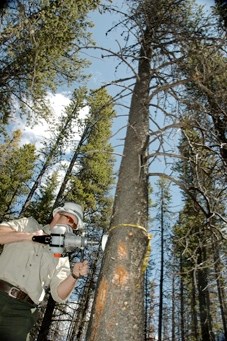There aren’t many Albertans who look forward to extremely cold winters, but Duncan MacDonnell with Alberta Sustainable Resources Development, does. While we’ve figured out how to survive the winters, a little pest known as mountain pine beetles don’t fare as well in the cold, something MacDonnell counts to keep their numbers in check.
“We had some cold winters there in ’07, ’08, ’09, there was lots of control work done there,” MacDonnell said. “Basically we removed every infested tree that we could find which lowered the pool of beetles available to attack new trees.”
The beetles make their home under the bark of pine trees, eventually killing it before moving onto the next one.
“Trees that are attacked by beetles have another generation inside waiting to emerge,” MacDonnell said. “Those are identified and the trees are cut down and burned on the spot, and that removes that bit of beetle from the potential pool.”
Over six million hectares of Alberta’s forests are at risk, but the Province has dedicated over $414 million since 2004 to the fight against the beetle, and so far in Southern Alberta, it’s working.
The Kananaskis invasion began in 2001, but MacDonnell said they’ve reduced the beetle in the area to nearly an undetectable level, due to the control work that was done in the area over the last decade, which involves burning infected trees. While the Southern Alberta is nearly mountain pine beetle free, MacDonnell said they’re still keeping a close eye on the area for potential infestations from the west.
“You've still got in Southeast British Columbia just over the Rockies there’s still some dense beetle infestation in those areas. They haven’t crossed the mountains and we're hoping they don’t, but that threat is still there,” he said. “That’s the real wild card. Are you gonna get them or are you not? We do detection surveys, bait traps, and watch for signs of infestation – pitch tubes and sawdust at the base of the tree. We’re just always on the lookout.”
While it may seem like a distant problem tucked away in the mountains, MacDonnell keeping the infestations under control is important, as one of the biggest threats the beetles pose is to our drinking water. If there were no trees in the mountains, the spring runoff would not be absorbed into the ground at the same rate, which would result in more water moving into the streams.
“Most of your municipal water systems are designed according to traditional water flows, but if the largest volume of the water is coming through earlier, your municipal systems may not be able to contain that water,” MacDonnell said. “You may have drought later on, so that’s the one big concern is potential change in hydrological patterns that can effect people living downstream.”
Wildlife who make their home in the mountains would also be at risk if the trees were to decline rapidly.
“You’re losing forest cover for bears and squirrels and deer and you leave your streams open to direct sunlight and higher temperatures,” MacDonnell said. “So maybe fish survival won’t be as good.”
And with tourism being a leading economic driver in Alberta, MacDonnell said dead forests aren’t exactly good for business.
“Areas that depend on that for their economic livelihood, I'm thinking of Crowsnest Pass, they have a lot of fisherman in there, it’s noted as a great fishing area, lot of hikers and campers,” he said. “Well if you've got a dead forest it's not going to be appealing to people so there’s a domino effect for local economies.”
But MacDonnell said they’re continuing with their strategy to fight the beetle the same as they do every year. With detection surveys, they’ve been able to identify high priority infestation areas and will work to remove the infected trees in those areas to help stop the spread.
“That doesn’t really change from year to year, its a sound strategy, it proved itself effective in Southern Alberta,” he said. “The tactics don't change, the locations do. Priorities for control work are west of Slave Lake, more around the Whitecourt area, we want to get in there and take out the denser concentrated areas.”
The province is also working on reforestation techniques to recover the forests lost to the pine beetle and will continue to restore the natural ecosystems in those areas.




